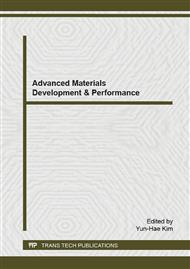p.77
p.82
p.88
p.92
p.96
p.100
p.107
p.113
p.118
Controlled Physical Gelation of Thermoresponsive Poly(2-propionamidoacrylic acid) Aqueous Solution
Abstract:
The thermoresponsive properties of aqueous poly (2-propionamidoacrylic acid) (PPA) solutions were studied in the presence of calcium chloride (CaCl2). The turbidity and viscosity of a PPA solution depended on temperature and concentration of the polymer and salt added. For example, a transparent PPA solution changed to a turbid gel at a temperature higher than the cloud point in the presence of a relatively high concentration of CaCl2. The mechanism of physical gelation was considered by comparing the thermoresponsive properties between PAA and a more hydrophilic polymer, poly (acetamidoacrylic acid) (P4A), which has similar structure to that of PPA. In the case of P4A, physical gelation was not observed under similar conditions to those at PPA gelation. This result indicates that hydrophobic interaction among the alkyl groups at one of the polymer side-chains is necessary for the gelation. Dynamic viscoelasticity measurements of these aqueous polymer solutions by use of a rotation rheometer gave quantitative data such as the complex viscosity and the storage and loss moduli, which strongly depended on the solution composition. It is concluded that both hydrophobic interaction among alkyl groups and ionic crosslinking by calcium ion play an important role for the gelation. The drastic change in the rheological property indicates that the sol-gel transition of PPA solution can be successfully controlled by adjusting the temperature and concentration of each component. The controllable rheological property is expected to be useful for various applications, especially in the biomedical field.
Info:
Periodical:
Pages:
96-99
Citation:
Online since:
June 2015
Authors:
Price:
Сopyright:
© 2015 Trans Tech Publications Ltd. All Rights Reserved
Share:
Citation:


